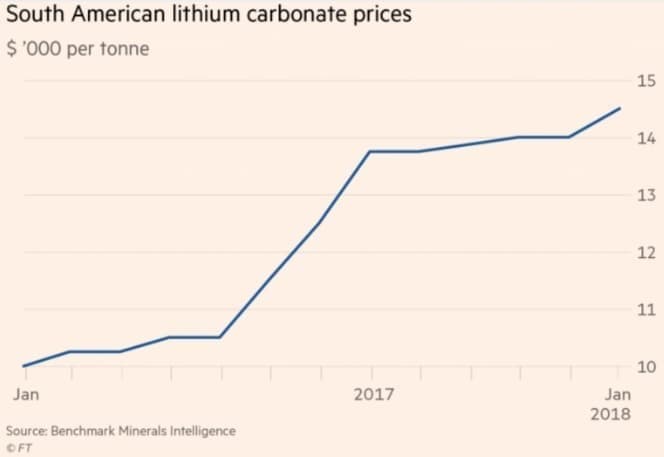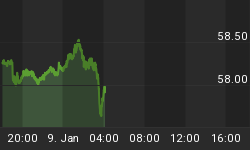It’s the modern gold rush. Around the world, the most sought-after mineral isn’t a precious metal, nor is it oil and gas…it’s lithium.
Lithium, or “white petroleum” as some call it, has become a crucial element in today’s high-tech economy.
Demand for lithium is soaring, and producers are frantically searching for new sources of supply. Prices have doubled in the last two years, rising as high as $16,500 per ton.

(Click to enlarge)
The biggest reason for the surge? The immense demand for lithium-ion batteries, needed to power electric vehicles (EV), cell phone and wind turbines.
As the Wall Street Journal reported, the surge in demand has pushed lithium miners to new areas in search of rich deposits.
Traditional production of lithium and lithium-ion batteries is concentrated in a few key areas, but with demand set to increase dramatically in the coming years, investors are searching for creative new ways to increase global supply.
A boom in Canadian lithium mining is pushing companies like Nemaska Lithium (TSX: NMX) and Power Metals Corp. (TSXV: PWM.V) to tap new deposits of lithium.
The fact that China is trying to corner the market has made the search for new deposits even more intense, as U.S. and European firms try to get around Chinese domination.
For the last five years, the commodities world has focused on the epic showdown between OPEC and U.S. shale drillers for oil market share. But it’s the war over “white petroleum” that will dominate the next decade.
Cornering the Market
In January, Zion Market Research projected lithium-ion battery sales to grow at an annualized rate of 13.7 percent, rising to $67.6 billion by 2022.
Lithium prices have risen stupendously in the last three years—from $6,500 per ton in 2015 to more than $20,000 in 2018. Related: The Five Biggest Bubbles In Stock Market History
China, which produces most of the world’s lithium batteries, has moved aggressively to secure steady supply. Chinese companies now own major shares in many South American lithium mines, where the bulk of the world’s lithium is produced, in order to feed Chinese battery factories.
China anticipates demand for lithium batteries to soar in coming years—mostly because they believe demand for electric vehicles (EVs) will exceed demand for gas-powered cars by 2030.
But the Chinese may be in for a surprise, as new mining companies secure deposits of lithium outside of South America.
Going Around the Chinese Wall
The Chinese may be investing heavily in South American lithium production in order to corner the market, but European and North American firms are side-stepping the Chinese autarchy to secure supplies of their own.
Europe uses 25 percent of the world’s lithium, while European auto-makers are anticipating a surge in EV production as the continent shifts away from gasoline-powered cars.
European investors are searching out lithium deposits in Germany and the Czech Republic. Meanwhile, drillers are mapping out underground lithium deposits in the UK, Portugal and Sweden.
In North America, miners are exploring for untapped lithium deposits that could rival the big finds in South America. Canadian miner Quantum Minerals Corp. (TSX-V: QMC) has expanded its Lithium Mine Project in Manitoba by 100 percent.
Another Canadian outfit, Nemaska Lithium Inc. (TSX: NMX) is hoping to exceed its current rate of production (16,000 tons) by 20 percent this year. The probable reserve of its property in Quebec is estimated at 24 million tons, which means it should have no problem reaching its production goals.
Nemaska has been a big winner on the lithium market: it rode its discoveries at their Whabouchi property in Canada to a $1.9 billion valuation.
Power Metals Corp, a hard-rock lithium driller is sitting on a deposit that could be worth billions. Rather than mine lithium through evaporation, which is very time-consuming, Power Metals uses drilling to tap into deposits of lithium spodumene trapped within the rock.
Canada could become a key source of lithium—which is good news for North American industry that may be losing access to Chinese lithium batteries.
One Door Closes, Another Opens
A trade war has broken out between China and the United States. While that’s bad news for some industries that rely on Chinese imports, its good news for North American lithium miners like Power Metals and Nemaska.
In early April, the U.S. government slapped a big tariff on imported Chinese lithium batteries, part of a tariff on Chinese goods worth $50 billion.
That means that lithium miners will see a bigger market for their products—and a surge of investment into North American mining, which has the lowest risk factor in the world.
China may be cornering the market on South American lithium in order to feed its battery factories and churn out electric cars, but protectionist policies by the U.S. and aggressive expansion into European lithium production may cut the Chinese out of the global battery market.
Booming demand for lithium could be fed by the lithium mines of Canada—turning junior miners into major players virtually overnight.
Power Metals has announced a 15000m drilling program for 2018. “The explorational upside is immense,” according to Dr. Julie Selway, the company’s hard-rock lithium expert, “and each drill target can substantially increase the overall resource size.”
Related: How Will Gold React As North Korean Tensions Cool?
Canadian lithium deposit, according to Selway, represent a “sleeping giant:” once tapped, it could provide enough lithium to satisfy North American demand.
Just as the world of oil has seen intense competition between OPEC and U.S. shale, the lithium world may be defined by its own war: China vs. Everyone Else.
In this new gold rush, it pays to be prepared for anything.
By. James Stafford
NOT AN INVESTMENT ADVISOR. Oilprice.com is not registered or licensed by any governing body in any jurisdiction to give investing advice or provide investment recommendation. ALWAYS DO YOUR OWN RESEARCH and consult with a licensed investment professional before making an investment. This communication should not be used as a basis for making any investment.
RISK OF INVESTING. Investing is inherently risky. While a potential for rewards exists, by investing, you are putting yourself at risk. You must be aware of the risks and be willing to accept them in order to invest in any type of security. Don't trade with money you can't afford to lose. This is neither a solicitation nor an offer to Buy/Sell securities.
RISK OF BIAS. We often own shares in the companies we feature. For those reasons, please be aware that we are extremely bias in regards to the companies we write about and feature in our newsletter and on our website.
More Top Reads From Safehaven.com:

















